Mayan Gods Referenced in Each Relic
| Relic | Relic Type | Gods Referenced in Relic | Relic Description |
|---|---|---|---|
|
mural 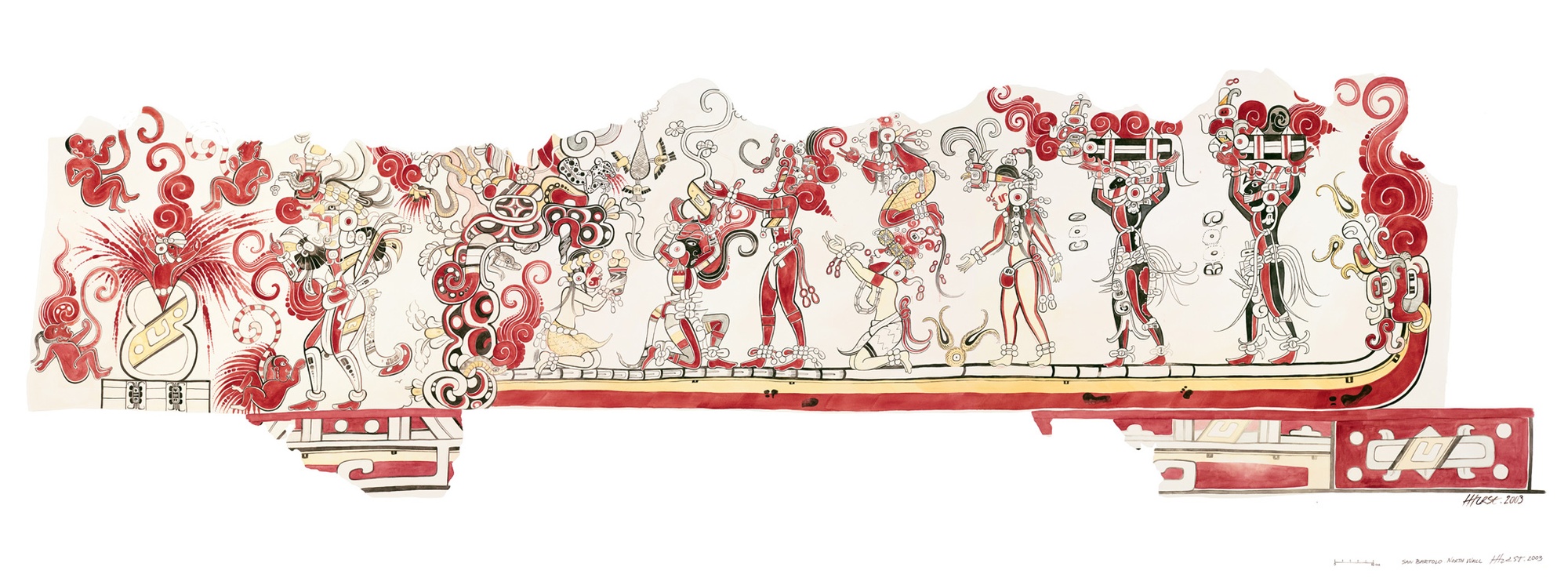
|
|
The north wall mural consists of two scenes. One scene is situated in front of a mountain cave (belonging to the Flower Mountain); several persons are walking and kneeling on a large serpent. The Maya maize god is shown in the midst of a group of men and women, while receiving (or perhaps bequeathing) a vine calabash. The other scene shows four babies, with their umbilical cords still attached, surrounding a calabash, which has now split up and from which a fifth, and fully clothed male emerges. A large deity figure watches the scene. The west wall mural has a far greater number of scenes. One part of the mural has four successive images of trees with birds, kings with the markings of the Maya Hero Twin Hunahpu, and sacrifices (consisting of fish, deer, turkey, and fragrant blossoms), to which a fifth tree has been added. The five trees are comparable to the directional trees of the Codex Borgia and to those mentioned in the Book of Chilam Balam of Chumayel; the associated birds represent the Principal Bird Deity. The sacrifices are comparable to those in the Year Bearer section of the Dresden Codex. The first four kings are shown piercing their penises (see fig.), spilling sacrificial blood, then offering a sacrifice. The fifth figure, associated with a fifth tree belonging to the centre - the tree of life itself - is the Maya maize god. The directional representation as a whole might refer to the initial arrangement of the world. Another part of the western mural depicts three scenes from the life of the maize god and the coronation of a king, showing divine right to rule coming from the gods, and providing evidence that the Maya had full-fledged monarchies centuries earlier than previously thought. The three maize god scenes show (i) a maize baby held by a man kneeling in the waters; (ii) the maize god inside a turtle cave, dancing before two enthroned, aquatic deities; and (iii) the maize god flying in the sky, or perhaps falling from the sky down into the water. Scene (iii) has been suggested to represent the death of the maize deity. Alternatively, it may refer to the maize god's role as a rain bringer. |
|
frieze 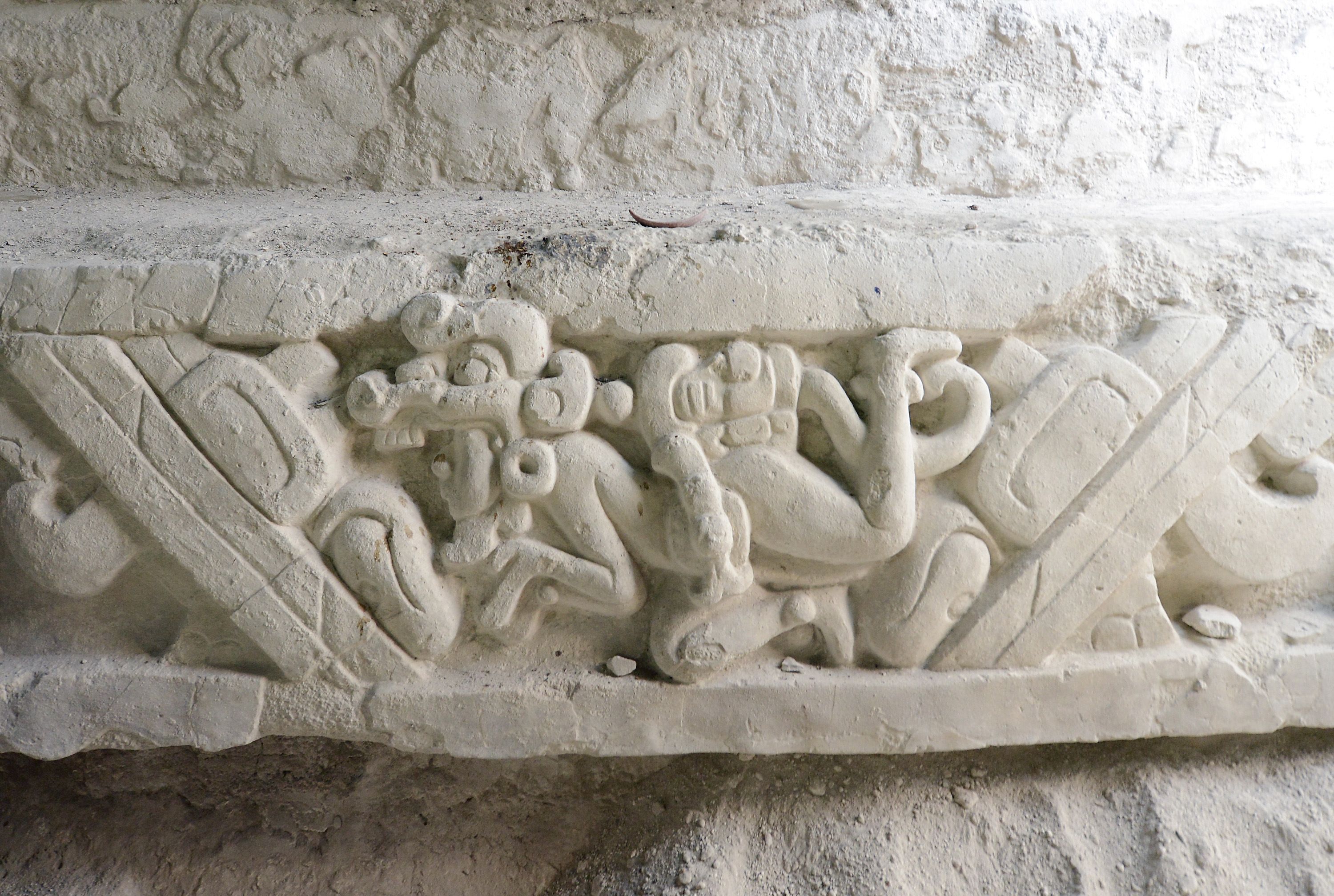
|
|
A long set of stucco friezes that depicts two more examples of Late Preclassic deity impersonation. The façades are located in a prominent pathway running east-west in the center of the “Central Acropolis.” They appear to front a large plaza at the base of the “Tecolote” pyramid complex, perhaps adorning part of an ancient water collection system (see map). The figures on the lower frieze have been associated with the Hero Twins, Hunahpu and Xbalanque, protagonists of the colonial K’iche Maya creation story, the Popol Vuh. Yet, in our view, these figures represent god impersonators and bear no secure connection to twins in the Popol Vuh. The lower, more prominent façade contains three beings: two humans with large headdresses, and the large profile head. The figure on the left, whose face is partially damaged, wears a headdress and shell ear spools. His one visible eye has the inverted-“L” found on some early gods; his mouth displays a circular outline, his outstretched arms and bent legs conform to the pattern of many diving figures in Maya art. The central figure wears a simple knotted belt with an effigy head attached to his lower back. His headdress and chinstrap form the gaping jaws of what is likely a version of Chahk, the god of rain: the diagnostic elements are the curled forehead (or hair) and especially the Spondylus ear spool. The figure on the viewer’s left shares many of the same features, but with different, tufted forehead, as though referring to another aspect of the rain deity. |
|
bones |
|
Two incised bones from the Temple I tomb in Tikal. One depicts three Chahks (Rain Gods) catching fish. The other depicts seven Maya deities travelling in a canoe to the Underworld. In the middle is the Maize God; at the left and right are the old Paddler Gods. |
|
jade |
|
Jade mosaic vase with portrait head of the Maize God, from Burial 196, a royal interment of the Late Classic period at Tikal, Guatemala. The pieces once adhered to a wooden interior, which has long since disintigrated. Ht: 9.5 inches (24.2 cm) |
|
ball court marker
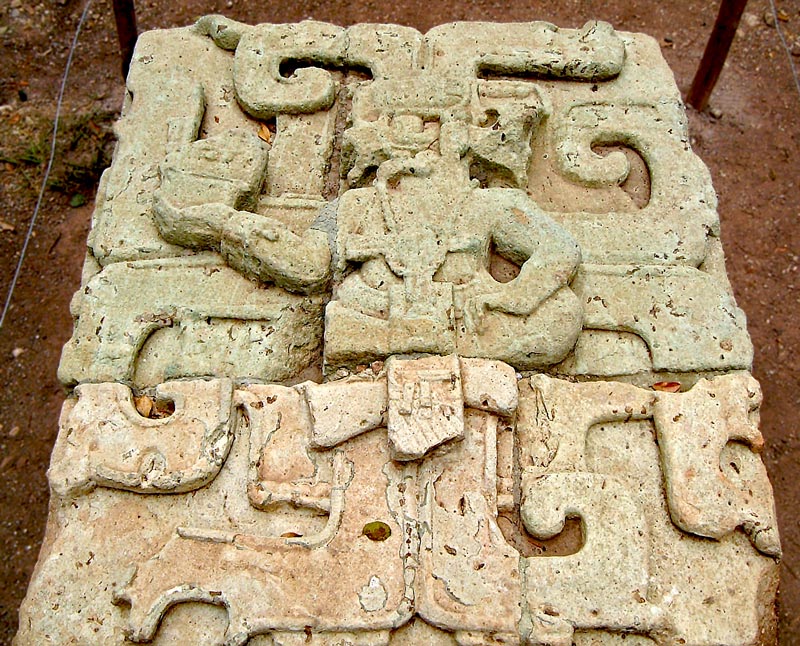
|
|
The stairs of Temple 11 in Copan also lead down to the underworld, which is defined by three Xibalban ball-court markers which are still located outside the Temple. The markers clearly show the evil looking Lords of Xibalba nestled amongst the roots of the Tree of Life. The stairs and sloping walls of Temple 11 act as one of the sloping walls of the ball-game arena, from the top of which the game can be watched. The sacred ball-game has its origins in a mythical game played by the Hero Twins, Hunuhpu and Xbalanque, who were asked to play against the the Lords of Xibalba. The myth ends with the boys winning the game and defeating the Lords of Xibabla and therefore defeating death. |
|
bust
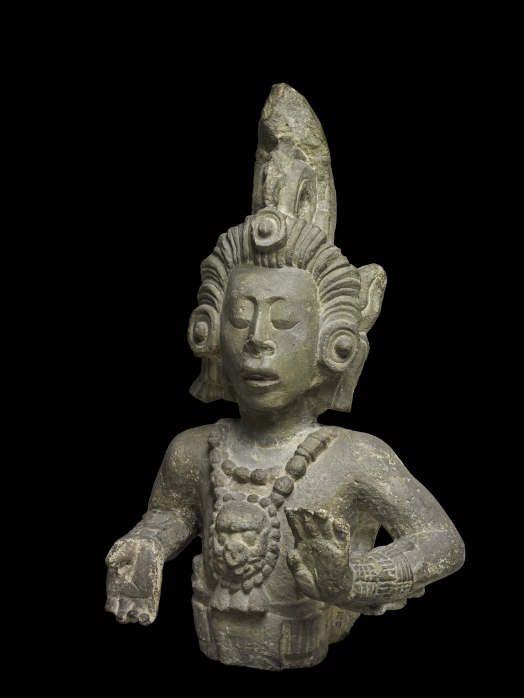
|
|
Stone bust of young Maize God, Temple 22. One of the wonderfully baroque sculptures from this site. |
|
temple sculpture 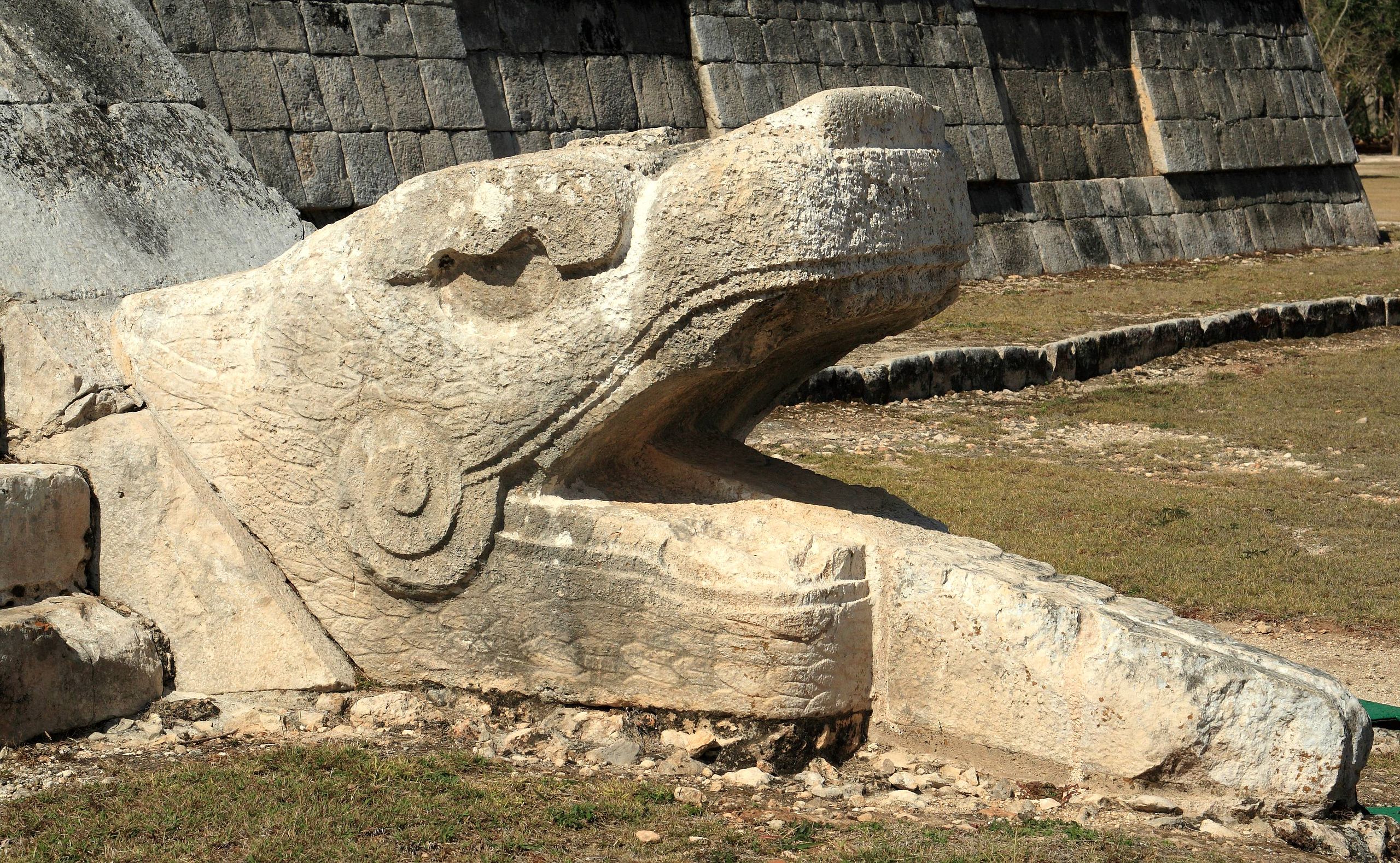
|
|
These sculptures of plumed serpents run down the sides of the northern balustrade. Around the spring and autumn equinoxes, the late afternoon sun strikes off the northwest corner of the pyramid and casts a series of triangular shadows against the northwest balustrade, creating the illusion of the feathered serpent "crawling" down the pyramid. To contemporary visitors, the event has been very popular and is witnessed by thousands at the spring equinox, but it is not known whether the phenomenon is a result of a purposeful design since the light-and-shadow effect can be observed without major changes during several weeks near the equinoxes. |
|
stela |
|
The Hero Twins gesture toward the Principal Bird Deity (Wuqub Caquix) as he descends to the fruit tree. Late Preclassic, c. 100 B.C. or later. |
|
stela |
|
A carved stone depiction of Mayan god of rain, Chahk (God G), standing on water. The decorations at the top, called a "sky band," was the Mayan artistic method of depicting the sky and the heavens above a scene. |
|
stela |
|
This Izapan stela depicts humanity emerging out of the World's Tree from the underworld, Xibalba. It possibly depicts a Mayan ritual. |
|
stela |
|
A ruler impersonating the Principal Bird Deity (Wuqub Kaquix) is carved on this granite stela. Ht 6 ft |
|
monument |
Monument 65 depicts high-ranking captives captured in battle, about to be sacrificed to the gods. |
|
|
tomb |
|
This carving on the upper surface of the sarcophagus found within the Funerary Crypt in the Temple of Inscriptions depicts the youthful-appearing Pakal the Great (the eighty-year-old king interred within the tomb) falling through gigantic fleshless jaws into the Underworld; above him rises the World Tree, surmounted by the bird-monster Wuqub Kaquix. Surrounding the scene is a band depicting celestial bodies and ancestral figures. AD 683. |
|
decor |
|
Its condition is very deteriorated, and it’s made of two constructions of medium dimensions that make up the sides of the court with the rings by which the ball was to be introduced. The originally carved stone rings were removed to protect them from the elements and were replaced by reproductions. This game has always been related to mythical and cosmic aspects. The ball symbolized the movements of the stars in the sky and the players, in repeated occasions, symbolically staged the fight of the day against the night or the struggle of the deities of the underworld against the gods of heaven. The date of construction was found in one of the calendrical symbols revealing the date in the year 906, time in which Uxmal began the decline. |
|
stela |
|
Stela 11 shows two standing figures in costume on the front, probably signifying the accession of the ruler Bird-Jaguar alongside his father and, in a quite different style, the reverse side again shows Bird-Jaguar, this time represented as the god Chahk, attacking three kneeling victims with his sceptre. |

